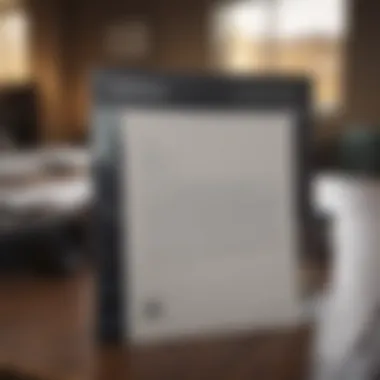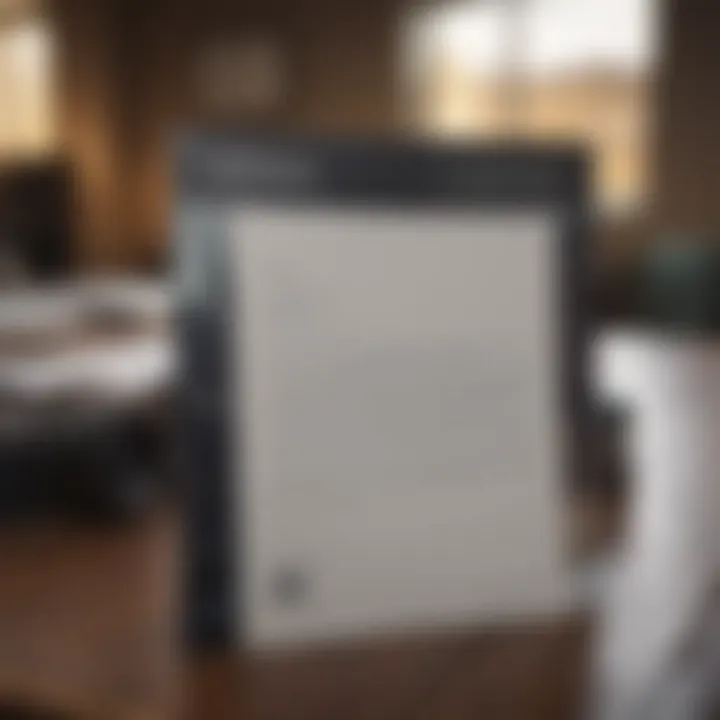Free Cover Letter Samples for Job Applications


Intro
A cover letter is an essential component of any job application. It provides an opportunity to expand on your resume and convey your personal brand. In this article, we will provide insights on crafting effective cover letters. This includes examining free samples tailored for different industries and the best practices for customization. Going beyond the basic components, we present tips for clarity and professionalism.
The relevance of a well-crafted cover letter cannot be overstated. It can be a deciding factor in whether your application stands out amidst a sea of candidates. This guide serves as a valuable resource for job seekers, enhancing not just the envelope that carries their resume, but the first impression they make with potential employers.
Key Components of a Cover Letter
A cover letter should include certain elements to be effective. First, start with your contact information at the top. That usually includes your name, phone number, email, and, optionally, your LinkedIn profile or online portfolio.
Next, address the letter to the hiring manager. Use a formal greeting, such as "Dear [Manager's Name]." If names are not available, a simple "Dear Hiring Manager" can suffice.
Structure Your Message
The body of your letter should be structured carefully. Typically, you will have three main paragraphs:
- Introduction: State the position you are applying for and how you heard about it.
- Body: Discuss your experiences and skills that relate to the job requirements. Use concrete examples of your accomplishments.
- Conclusion: Express enthusiasm for the position. Thank the employer for considering your application and state that you look forward to the opportunity for an interview.
Lastly, always end with a formal closing. A simple "Sincerely" followed by your name is adequate. Consider including your handwritten signature if you are submitting a printed copy.
Tailoring Your Cover Letter
Customization is a key aspect in writing cover letters that resonate. Take time to research the company. Understand their values, culture, and any recent news. Align your skills and experiences with the points that matter most to the employer.
“A tailored cover letter demonstrates genuine interest and effort, making your application more appealing.”
Focus on sections of the job posting that mention specific skills or qualities the employer seeks. Address these directly. Use language that reflects the company’s tone, which can often be found on their website or social media profiles.
Samples and Formatting
Finding free samples of cover letters on reputable sources could be useful. When adapting any sample, ensure that it fits your unique voice and personal experiences. Common places for samples can be sites like Wikipedia and Britannica.
Additionally, maintaining professionalism in your formatting matters. Keep your letter to one page, use standard fonts such as Arial or Times New Roman, and leave appropriate margins.
Lastly, utilize bullet points when listing qualifications or achievements, so they stand out. Uncluttered formatting guides the reader's eye and enhances comprehension.
With careful customization, structured format, and appealing presentation, your cover letter can elevate your application significantly.
Understanding the Role of a Cover Letter
A cover letter serves as a companion to your resume, offering additional insight into your qualifications for a job. Understanding its role is crucial for anyone seeking employment. This document is not simply a formality. Instead, it provides an opportunity to distinguish oneself from other applicants.
A well-written cover letter communicates individual identity, background, and fit for a specific role. It allows candidates to express their interest in the position. Moreover, it presents a chance to echo the elements highlighted in the resume, framing those qualifications in a narrative context. This connection underscores your suitability for the role and fosters a deeper understanding of your career path.
Another important facet is the ability to personalize your outlook. Each job application can benefit from tailored content that shows you have engaged with the company's culture and values. A cover letter can also address any gaps in employment, potential concerns, or highlight particular achievements relevant to the criteria set out in the job posting. Overall, recognizing the role of a cover letter enables job seekers to present themselves more dynamically.
What is a Cover Letter?
A cover letter is essentially a short introductory letter included with your job application materials. Its focus is to introduce you to the hiring manager and outline why you are a good fit for the position you want.
Typically, it contains several elements:
- A brief introduction of yourself.
- A summary of relevant experience and skills.
- Why you are particularly interested in this job.
- A professional closing.
It must be concise yet informative. Less than a full-page length is often preferred, ensuring readability without excessive wordiness. The letter opens the door to a more personal connection, moving beyond the dry facts of a resume.
Purpose of a Cover Letter in Job Applications
The cover letter's primary purpose in job applications is to provide context to the resume. It gives candidates a platform to articulate particular successes that their resume can only hint at.
Importantly, it helps to establish a voice and approach that reflects personality along with professionalism.
Some specific reasons why a cover letter is crucial include:
- It allows you to showcase specific attributes that align directly with the job requirements.
- It serves to demonstrate communication skills and thought organization.
- It can indicate your genuine interest in the company and the role.
- It acts as a link between your experiences and the needs of the employer, which makes a stronger case for your candidacy.


"A cover letter can be the difference between an application that gets noticed and one that fades into anonymity."
Key Components of an Effective Cover Letter
In the realm of job applications, the cover letter plays a vital role. It serves as an opportunity to present oneself to potential employers and share insights beyond what a resume offers. The components of an effective cover letter determine its impact and clarity. A well-structured letter can catch the hiring manager's attention, showcasing individuality while aligning with the job requirements. Attention to key components is tacitly significant as it builds a framework that guides the writer in delivering a persuasive message.
Preamble and Salutation
The introduction sets the tone for the cover letter. It should clearly state the position for which the applicant is applying and capture the reader's interest. Including a personal greeting, tailored to the recipient, enhances connection. For instance, addressing the hiring manager directly rather than using a generic greeting cultivates a relationship of familiarity. An articulate introduction is essential; it provides context and motivates the reader to continue. Consequently, this lays the groundwork for the content that follows deeply impacting the reader's perception of the applicant.
Body Paragraphs
The body of the cover letter allows candidates to elaborate on their fit for the role. Each paragraph should focus on distinct aspects that contribute to the application. It's worthwhile to present well-edited case studies or anecdotes. Effective structure in this section maintains clarity.
Highlighting Relevant Experience
Discussing relevant experience is essential in establishing credibility. This aspect communicates the applicant's potential contribution to the organization better than generic statements. Mentioning specific job roles or actions allows candidates to convey substantial context. Highlighting accomplishments that correlate directly with the job shows a direct relevance to employers. This targeted approach makes it a popular choice, as it leaves a lasting impression and engages the reader’s attention. Should they recognize familiar experiences, it increases the chances of screening success.
Demonstrating Skills and Qualifications
Skills and qualifications indicate what makes an applicant suitable. This section emphasizes the unique traits that make one stand out, such as technical proficiencies or soft skills like communication. It directly points toward the position’s requisites, methodically listing abilities that pair with duties described in a job posting. This normalization helps ensure confidence in conveying capabilities. Using PC or project management software examples enhances the delivery practicality of this paragraph, contributing to good narrative flow.
Expressing Enthusiasm for the Position
Demonstrating enthusiasm shows candidates are willing to contribute more than just qualifications. It embodies genuine interest, reducing the perception of stamp applications. Outlining motivation enhances engagement value, making this element crucial. A well-articulated doting on the organization's mission or culture has a way of accentuating potential synergies. Candidates often overlook the importance of genuine excitement. However, “fit” is often as significant as skills evaluated by hiring managers, presenting applicants who align well.
The End and Call to Action
In summary, concluding remarks wrap up the narrative succinctly. A solid conclusion should reiterate interest in the position and suggest readiness for an interview. The call to action is vital, creating a sense of urgency. It gently nudges employers to engage further, paving the way toward potential opportunities. Referencing a follow-up demonstrates professional proactivity. Employers may take cues from persuasive closer and engaged communication style fitting modern workplaces emphasizing clarity. Enhancing the tone in this section can remarkably transform forward views on proposals, hence very beneficial overall.
Free Sample Cover Letters
Free Samples of cover letters provide valuable resources for those aiming to create effective job application materials. They serve as practical guides that outline structures, language, and tone suitable for different career levels and sectors. These samples offer several benefits, such as helping candidates present their qualifications, skills, and experiences in a tailored way. Understanding these samples features enables job applicants to craft letters that resonate with potential employers, improving their chances of landing an interview.
Sample Cover Letter for Entry-Level Positions
An entry-level position often requires tailored content to highlight eager-learning and adaptable qualities. The sample cover letter for this category should begin with a clear introduction that states the specific job being applied for. Candidates must identify transferable skills gained from internships, projects, or volunteer work. These experiences may include:
- Group work
- Participation in relevant clubs
- Academic projects
- Part-time jobs related to the field
Demonstrating a willingness to learn and grow, such a cover letter can help to bridge the gap between limited experience and the capability to succeed in the desired position. It's important to convey enthusiasm and readiness to contribute.
Sample Cover Letter for Mid-Career Professionals
For mid-career specialists, the expectation changes. The sample cover letter must confirm expertise and accomplishments while demonstrating eagerness for a new challenge. This type of cover letter should include details like:
- Notable achievements in previous roles
- Relevant certifications or professional development
- Leadership roles assumed or initiatives taken
Addressing how past roles have prepared the candidate for the prospective position is essential. This can show hiring managers that the applicant is not just experienced but also well-suited for future demands. Besides skills and experience, a personal insight into professional values can add a fitting touch to the narrative presented.
Sample Cover Letter for Executive Positions
At the executive level, a cover letter serves as a critical showcase of leadership capabilities and strategic vision. A suitable sample cover letter for such capicity must encompass:
- Clear articulation of success in previous executive roles
- Impactful leadership examples that pave way for effective management
- Vision for the prospective role in aligning company goals and strategic initiatives
The sample should stress capabilities in driving teams and organizations towards achieving significant outcomes. Customized content that aligns with corporate values will capture attention. Professionalism and confidence in phrasing ensure the suitability for high-stakes roles.
In each of these samples, clarity is key. Proper structure and targeted content facilitate engagement with potential employers. By assimilating these layouts and the intent behind them, applicants are better equipped to create impactful cover letters.
Tips for Customizing Your Cover Letter
Customizing your cover letter is crucial. It demonstrates your genuine interest in the position and shows that you have taken the time to understand the company. A generic cover letter may not capture the attention of hiring managers. In contrast, a tailored cover letter speaks directly to the unique aspects of the job and the organization, enhancing your chances of moving forward in the application process.
Researching the Company


Understanding the company for which you are applying is a vital component of customization. Take time to research its mission, values, and culture. This information can usually be found on the company's website or through articles and interviews.
- Incorporating insights about the company’s initiatives can make your cover letter stand out.
- Mention any notable passions or policies the company holds that align with your own experience and ambitions.
- Reflect the company’s tone and language in your writing can also demonstrate a good fit.
Driving these points home shows the hiring official that you value the opportunity to contribute meaningfully within their context.
Tailoring Content to the Job Description
Every job description highlights certain skills and tasks that are essential for the role. Be alert to these specifics as you draft. Focus on how your experiences align with the expectations listed.
- Layout your relevant qualifications explicitly. Align those points neatly with the requirements stated in the ad.
- Use examples from your previous work that provide clear ties to prospective responsibilities.
- Following these steps can also emphasize your proactive approach: Great employers appreciate candidates who acknowledge job specifics rather than just glossing over the surface.
Tailoring content reinforces the reason behind your interest in the position and how you can add value.
Using Keywords from the Job Posting
Keywords from the job posting serve a dual purpose. They inform you about what a hiring manager is searching for and help your resume and cover letter pass through applicant tracking systems. They scan for consistency between your application materials and the language used in the job description.
- Identify core competencies and essential qualifications mentioned in the posting.
- As you weave these terms seamlessly into your cover letter, ensure the context remains sound.
- Doing so raises the likelihood of catching the attention of both automated systems and human review, enhancing your chances of a favorable outcome.
Remember, without targeted keywords, your cover letter risks being overlooked in favor of other applicants.
Implementing these strategies while customizing your cover letter lends structure and purpose to your application, significantly increasing your chances of making a lasting impression.
Common Mistakes to Avoid
Crafting a compelling cover letter is not just about what to include; it is equally vital to avoid common pitfalls. Mistakes can detract from the overall effectiveness of the application and reflect poorly on the candidate. Recognizing and sidestepping these errors can enhance one's chance of securing an interview. Below, we examine specific mistakes that are prevalent yet avoidable.
Generic Language and Templates
A frequent mistake is relying on generic language and overused templates. Many candidates fall into the trap of using boilerplate phrases without customization. This can make the cover letter feel impersonal and can result in a lack of connection with the reader. Employers can instantly see when an applicant has taken the shortcut of not personalizing their letter. To avoid this, take time to tailor the letter to the specific position and organization.
Key Considerations:
- Be Specific: Use concrete examples from your experience that relate to the job being applied to.
- Personalize Testimonials: Reference why you are interested in the role or company, perhaps reflecting insights learned through the application.
Excessive Length
A lengthy cover letter creates the risk of losing the reader's attention. Writing too much can overwhelm employers with information mostly deemed unnecessary or tangential. It's crucial to aim for clarity and brevity while delivering all crucial points. Smart application means delivering essential information succinctly.
Suggested Length:
- Aim for 300 to 400 words. This encompasses sufficient detail without leading into verbose presentations.
Benefits of Shortening Length:
- Respecting the reader's time by getting to the point.
- Enhances comprehension, allowing for sharper focus on key qualifications.
Ignoring Formatting Guidelines
Formatting plays an essential role in how your cover letter is perceived. Ignoring specified guidelines can undermine the impact of even an otherwise strong letter. Adhering to formatting norms reflects professionalism and attention to detail.
Important Aspects of Formatting:
- Consistent Font: A professional-looking font such as Times New Roman or Arial should be utilized, typically in 12-point size.
- Appropriate Margins: Standard one-inch margins maintain a professional look.
- Clear Structure: Proper use of paragraphs and headings can enhance readability.
Remember, the presentation of your cover letter can be just as important as its content.
Summary of Mistakes to Avoid
- Refrain from using cliches or templates without customization.
- Keep your letter concise to respect the reviewer's time.
- Follow all formatting rage-setting guidelines closely.
By keeping these common mistakes top of mind, candidates can significantly improve the quality and effectiveness of their cover letters.
Formatting Your Cover Letter


The formatting of your cover letter is a crucial aspect that influences how it is perceived by potential employers. A well-structured letter not only enhances readability but also creates a professional impression. Even the most compelling content can be overlooked if it is improperly formatted. Thus, focus should be on clarity, structure, and visual appeal.
Layout and Structure
The layout of your cover letter should lead the reader's eye naturally from one section to the next. Start with your name and contact information at the top, followed by the date and the employer's details. Ensuring each of these elements is distinct and easy to read helps make a positive first impression. Use headings wisely to demarcate sections if needed, but don’t rely excessively on visuals which may detract from the message itself. A clean and simple layout is ideal. The layout should consist of four main parts:
- Your Contact Information
- Date
- Employer’s Contact Information
- Greeting
Double-check that the address you are sending the letter to is accurate and that the name of the person is spelled correctly. Such attention to detail reflects your care and professionalism, setting a positive tone early on.
Font Selection and Size
When it comes to font selection, consistency is key. Choose a font that is easy to read and looks professional. Common choices include Times New Roman, Arial, or Calibri. The font size should generally be between 10.5 to 12 points. Using a larger font for headings can help break the text into manageable sections but avoid excessively big fonts that may appear unprofessional. Inconsistency in font choices or sizes can lead to API distractions, drawing attention away from the laws content.
Spacing and Margins
Adequate spacing enhances readability. Use single spacing within paragraphs and double spacing between paragraphs if necessary. Aim for at least one inch of margins on all sides. Hover Paragraphs tug two Bore widde do not start on the same lines but allow for clear visual breaks. Formatting choices, though they may seem minor, cumulatively impact the reader's experience, making it crucial to optimize these elements carefully.
“A well-formatted cover letter stands out even before a sentence is read.”
Effective cover letter formatting aligns your document with the implicit expectations of recruiters, easing their review process. When your letter flows correctly, its likelihood of success increases.
The Importance of Proofreading
In the quest to create a compelling cover letter, proofreading takes on significant importance. It could be the factor that distinguishes an average application from a remarkable one. Opportunities can slip away due to overlooked details. Subtle mistakes can undermine the professionalism of your entire application. For a reader, particularly a potential employer, any signs of carelessness could lead to a quick dismissal of your candidacy.
Mistakes such as typos, grammar errors, or awkward phrasing not only alter meaning but can also reflect poorly on the applicant’s attention to detail. A thorough proofreading process acts as a safeguard, ensuring that clarity and professionalism define every submission. Taking time to review allows you to refine your arguments and ensure you leave a lasting impression.
Identifying Typos and Grammatical Errors
Identifying typos and grammatical errors is one of the primary aspects of proofreading. Mistakes in spelling or punctuation can create confusion. مثuentes susceptible to misinterpretation diminish the full impact of your sentiments. Those errors may leave an impression of neglect or lack of effort, which few applicants can afford.
While proofreading, it’s beneficial to read your letter out loud. This technique unveils spots where the flow may be disrupted by poor punctuation. Consider each word carefully. A correct and polished piece drives home the point of being a serious candidate, reflecting directly on one’s capability and diligence.
Ensuring Clarity and Precision
Ensuring clarity and precision should be a top goal during proofreading. The message should convey the intent without ambiguity. When clarity is enhanced, the reader can focus on the merits presented instead of wading through convoluted prose. A precise cover letter walks a fine line between too much jargon and overly simplistic structures.
Comprehensiveness is essential, but it must be communicated with simplicity. Thus, speak directly and avoid convoluted expressions. If the components of your letter are straightforward, they achieve greater impact on the recipient. Precision allows the narrative of your qualifications to shine through while reinforcing its relevance to the potential employer's expectations.
Getting External Feedback
Getting external feedback plays a crucial role in covering all possible blind spots. Independent reviews from job seekers, peers, or mentors on your cover letter can spot faults you may overlook due to familiarity. Fresh perspectives often catch errors that one notices developer improves the overall quality of the presentation.
Solict feedback on structure, tone, and content quality in addition to grammar. Aim to apply constructive criticism effectively. Remember, engaging with others can provide insights that improve your application, leveraging a tool you create the first time into something far more impressive.
Effective proofreading creates a submission that reflects attention to detail and professionalism, making it advisable and vital.
Insights gleaned from feedback can refine the final product enduringly. Ultimately new diligence in this matter underscores your offerings in pursuit of professional growth.
Final Thoughts on Crafting a Cover Letter
Crafting an effective cover letter is essential for any job application. It serves as a first impression to prospective employers, highlighting one's personality, experience, and professionalism in a manner that a resume alone may not convey. A well-structured cover letter complements the resume and reinforces the qualifications listed there, providing context and depth. Thus, taking the time to develop this document carefully can significantly affect one’s job search success.
Reflecting on Your Unique Value
Every individual offers distinct experiences and capabilities. Hence, the cover letter should effectively showcase this unique value. When writing, it is vital to emphasize what makes you different from other candidates. Consider specific skills, achievements, and attributes that pertain to the role. It is not enough to merely state qualifications; one should also provide acts that represent these claims.
To reflect on your unique value adequately, ask yourself several questions:
- What achievements in your career are particularly notable?
- Have you overcome significant challenges in your previous roles?
- Which personal attributes align with the company culture?
Drafting answers to these questions can help frame your cover letter in a way that transcends standard qualifications, making it memorable.
The Lasting Impact of a Strong Cover Letter
A strong cover letter does more than just list qualifications. It creates a narrative that allows employers to visualize you as part of their team. It can also convey emotions and motivations—elements often overlooked in a resume.
Good cover letters have several benefits:
- Sets the Tone: It establishes a professional tone, often paralleling expectations within the industry.
- Engagement: It promotes the candidate's personality, providing a more engaging experience for hiring managers.
- Reference Points: A well-written cover letter serves to reference discussions during interviews.
Hiring managers frequently recount the power of a cover letter that resonates. This power lies not only in its content but in how it connects the candidate with the mission of the organization. In conclusion, taking the time to craft a tailored and thoughtful cover letter can be the substantial difference between being overlooked and landing that crucial job interview.



